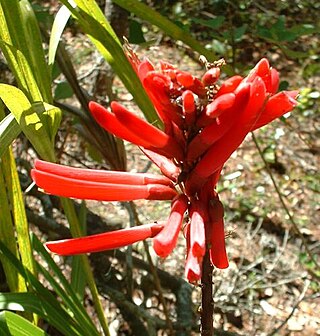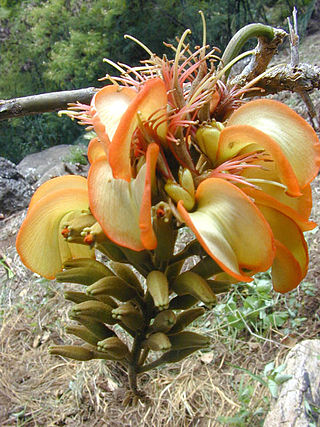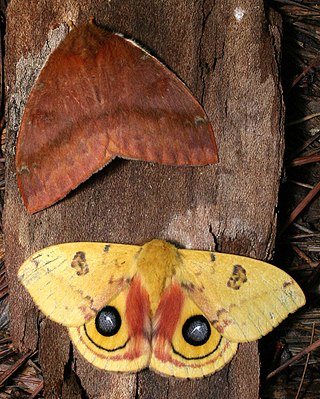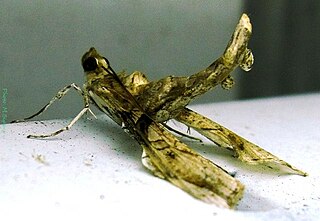
Erythrina is a genus of plants in the pea family, Fabaceae. It contains about 130 species, which are distributed in tropical and subtropical regions worldwide. They are trees, with the larger species growing up to 30 m (98 ft) in height. The generic name is derived from the Greek word ερυθρóς erythros, meaning "red", referring to the flower color of certain species.

Erythrina herbacea, commonly known as the coral bean, Cherokee bean, Mamou plant in South Louisiana, red cardinal or cardinal spear, is a flowering shrub or small tree found throughout the southeastern United States and northeastern Mexico; it has also been reported from parts of Central America and, as an introduced species, from Pakistan. Various other systematic names have been used for this plant in the past, including Erythrina arborea, Erythrina hederifolia, Erythrina humilis, Erythrina rubicunda, Corallodendron herbaceum and Xyphanthus hederifolius.

Wiliwili is a species of tree in the pea family, Fabaceae, that is endemic to the Hawaiian Islands. It is the only species of Erythrina that naturally occurs there. It is typically found in Hawaiian tropical dry forests on leeward island slopes up to an elevation of 600 m (2,000 ft).

Frass refers loosely to the more or less solid excreta of insects, and to certain other related matter.

Erythrina crista-galli, also known as the cockspur coral tree or ceibo, is a species of flowering tree in the family Fabaceae, native to Argentina, Uruguay, southern Brazil and Paraguay. It is widely planted as a street or garden tree in other countries, notably in California. Its specific epithet crista-galli means "cock's comb" in Latin.

Automeris io, the Io moth or peacock moth, is a colorful North American moth in the family Saturniidae. The Io moth is also a member of the subfamily Hemileucinae. The name Io comes from Greek mythology in which Io was a mortal lover of Zeus. The Io moth ranges from the southeast corner of Manitoba and in the southern extremes of Ontario, Quebec, New Brunswick and Nova Scotia in Canada, and in the US it is found from Montana, North Dakota, South Dakota, Nebraska, Colorado, New Mexico, Texas, Utah, east of those states and down to the southern end of Florida. The species was first described by Johan Christian Fabricius in 1775.

Erythrina variegata, commonly known as tiger's claw or Indian coral tree, is a species of Erythrina native to the tropical and subtropical regions of eastern Africa, the Indian subcontinent, northern Australia, and the islands of the Indian Ocean and the western Pacific Ocean east to Fiji.

Erythrina fusca is a species of flowering tree in the legume family, Fabaceae. It is known by many common names, including purple coraltree, gallito, bois immortelle, bucayo, and the more ambiguous "bucare" and "coral bean". E. fusca has the widest distribution of any Erythrina species; it is the only one found in both the New and Old World. It grows on coasts and along rivers in tropical Asia, Oceania, the Mascarene Islands, Madagascar, Africa, and the Neotropics.

Terastia is a genus of snout moths in the subfamily Spilomelinae of the family Crambidae. It was described by Achille Guenée in 1854 with Terastia meticulosalis as type species. The genus is currently placed in the tribe Margaroniini, where it is closely related to the genera Agathodes and Liopasia.

Eudocima phalonia, the common fruit-piercing moth, is a fruit piercing moth of the family Erebidae. The species was first described by Carl Linnaeus in his 1763 Centuria Insectorum. It is found in large parts of the tropics, mainly in Asia, Africa and Australia but introduced into other areas such as Hawaii, New Zealand and the Society Islands. It is one of major fruit pests in the world.

Agathodes ostentalis, the coral tree moth, is a species of moth of the family Crambidae described by Carl Geyer in 1837. It is found from India to Indonesia, including Hong Kong, Japan, Thailand and in Australia in New South Wales and Queensland.

Erythrina velutina is a species of leguminous tree. It is indigenous to Brazil, Peru, Ecuador, Colombia, Venezuela, and Hispaniola and has been introduced to much of the Caribbean, Uganda, and Sri Lanka. It also occurs on the Galápagos Islands, but whether it is indigenous or introduced there is unclear. In Brazil, it occurs on plains and near rivers in the arid parts of the northeast of the country and is commonly known as "mulungu". Erythrina velutina grows as a large tree to around 10 m (30 ft) high and has short spines on the stem. It is perennial.

Terastia subjectalis is a moth of the family Crambidae. It occurs across the Indian and south Pacific oceans, including Fiji, Hawaii, Réunion, Okinawa, Samoa, the Society Islands, Sri Lanka and Australia.

Terastia egialealis is a moth in the family Crambidae and subfamily Spilomelinae. The species was first described by Francis Walker in 1859. It is found in India, China, Nepal, Thailand, West Malaysia, Sumatra, Java, Borneo, and Sulawesi.

Erythrina zeyheri, commonly known as the ploughbreaker, is a deciduous, geoxylic subshrub and member of the Fabaceae, which is endemic to southern Africa. It grows no more than 60 cm tall and occurs naturally in the higher elevation grasslands of South Africa's central plateau, and that of adjacent Lesotho. They favour deep clay soil in the vicinity of creeks and marshes, and often form colonies. Its specific name commemorates the 19th century botanist, Karl Zeyher.
Agathodes musivalis is a species of moth of the family Crambidae described by Achille Guenée in 1854. It is found in Mayotte, Congo, Kenya, Réunion, Malawi, Mauritius, Madagascar, Mozambique, Somalia, South Africa, Uganda, Zambia and Zimbabwe.
Agathodes designalis, the sky-pointing moth, is a moth in the family Crambidae. It was described by Achille Guenée in 1854. It lives in Arizona, Texas, Florida, southern South America and the West Indies.

Teliphasa erythrina is a species of moth of the family Pyralidae. It is found in China (Yunnan).

Twig borer refers to a number of species of beetles and moths that chew holes into small branches of trees and shrubs. Many of these insects are agricultural pests. Animals that are called twig borers include:

Erythrina corallodendron, the red bean tree, is a species of flowering plant in the family Fabaceae. It is native to the Caribbean; Jamaica, Hispaniola, Puerto Rico, the Leeward Islands, and the Windward Islands, and has been introduced to Trinidad and Tobago, Kenya, Réunion, and the Malay Peninsula. A small tree usually 3 m (10 ft) tall, but rarely reaching 10 m (33 ft), and with showy flowers, it is often planted as an ornamental.


















